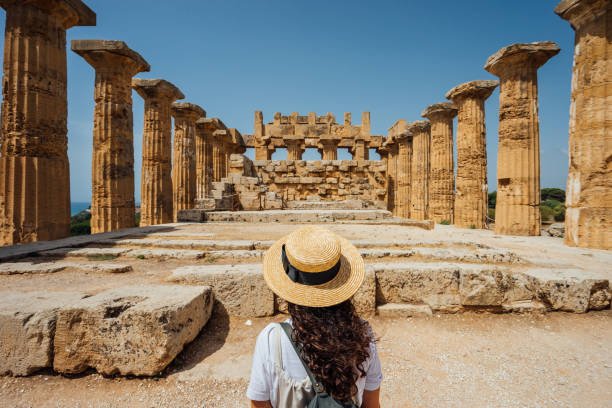If you’re going to go to a UNESCO World Heritage site, make sure to include these main sites on your itinerary.
Certain places captivate the imagination of the globe not only for their beauty and human ingenuity, but also for the unique insight into the past that each persistent locale affords. These ten UNESCO World Heritage Sites, which include many of the Seven New Wonders of the World, are among the most popular tourist destinations on the planet. You don’t need to be a history nerd to enjoy these fascinating historical sites.
1. Machu Picchu
Aguas Calientes, Peru
Machu Picchu, perched nearly 8,000 feet above sea level in the Peruvian Andes, flows down a spectacular mountain spine flanked by the craggy peaks of the Sacred Valley. Every year, millions of people visit this UNESCO World Heritage site to see the citadel’s terraces and traditional dry stone architecture. Machu Picchu, despite being one of the top World Heritage sites, had a brief existence. It was built in 1450 by the Incas but abandoned a century later during the Spanish conquest.
2. Angkor Wat
Siem Reap, Cambodia
Angkor Wat is one of the most picturesque World Heritage sites and distinctive religious constructions, with its vast moat and drip sand castle-like towers. During the 12th century, King Suryavarman II, the monarch of Southeast Asia’s old Khmer Empire, oversaw the building. When you realise that the Hindu temple complex, a network of stone temples covered with elaborate carvings of devatas (Hindu deities), is just one of the sights at the UNESCO-designated Angkor Archaeological Park, it’s even more spectacular. The complex, which spans 400 acres in northeastern Cambodia, also includes inhabited communities and many more architecturally notable jungle-intertwined ruins and temples, including one featured in Angelina Jolie’s 2001 Tomb Raider film.
3. Petra
Wadi Musa, Jordan
Petra, Jordan’s most famous archaeological site, was once a thriving trade centre where locals traded Arabian incense, Chinese silks, and Indian spices. The ancient city of Nabatea was founded about 400 B.C.E. in the country’s southwestern desert, but it was unknown to the Western world until the 1800s. It feels otherworldly because it is reached by a narrow canyon and features tall temples and tombs carved into pink sandstone cliffs (thus the name “Red-Rose City”). Perhaps this is why, in Indiana Jones and the Last Crusade, Petra’s Treasury served as a stand-in for the temple housing the Holy Grail.
4. Stonehenge
Wiltshire, United Kingdom
Stonehenge, a circle of stone megaliths in the English countryside, is thought to have been built around 2500 B.C.E., although the cause for its construction is unknown. Some archaeologists believe the structures were created for religious activities, while others believe they were used to examine the sun and moon’s movements. In any case, the structure was a feat of engineering. (Workers hammered wood wedges into fissures in the stone and then used rope to pull each mass upright to shape Stonehenge’s megalithic constructions.)
5. The Parthenon
Athens, Greece
This antique and partially preserved temple, perched atop the Acropolis hill in Athens, has watched over Greece’s capital city since the Athenian Empire was at its peak of glory. The Parthenon, dedicated to the goddess Athena, was built in 447 B.C.E. by the Athenians to commemorate their triumph over Persian invaders. It has since served as a city treasury, a Christian church dedicated to the Virgin Mary, and a mosque during the Ottoman takeover. The Parthenon frieze (although some sections are still controversially on display at London’s British Museum), artefacts discovered on Acropolis hill, and even the remains of an ancient neighbourhood uncovered during the museum’s construction are all on display at the Acropolis Museum, which is located at the foot of the Acropolis.
6. The Great Wall of China
Beijing, China
The Great Wall, China’s most iconic emblem, was built over 2,500 years and spans more than 13,000 kilometres in the northern region of the country. The Zhou dynasty–era state of Chu began construction on the wall in the 8th century B.C.E. to protect against foreign invasions. Most visitors only visit a portion or two of the stone and brick fortress; seeing the complete wall would take 177 days of uninterrupted walking.
7. Taj Mahal
Agra, India
The Taj Mahal has a 240-foot-tall central dome and a semiprecious stone-inlaid façade. The white marble mausoleum was built between 1631 and 1648 to honour Mughal Emperor Shah Jahan’s late wife and is widely regarded as the most exquisite existing example of Mughal architecture. (To finish the project, he enlisted the help of 20,000 of Central Asia’s top craftsmen.) Jahan planned to construct a second mausoleum for himself, but the project was never completed. The emperor was buried next to his wife after his death in 1666. The grounds of this World Heritage site have a large garden with lengthy reflecting pools of water and a red granite gate that visitors can explore.
8. Easter Island
Chile
This lonely island, located 2,200 miles off the coast of Chile, was named by Dutch explorers who discovered the continent on Easter Sunday in the 18th century. It is known for its approximately 1,000 mammoth statues, which were erected by Indigenous Polynesian inhabitants to symbolise their ancestors between the 10th and 16th centuries. The greatest spot to see the carved figures, or moai, is Rapa Nui National Park, which spans half of Easter Island. At the old quarry Rano Raraku, there are roughly 400 moai, including a 70-foot-tall monument that was never raised upright. Tongariki, the most prominent site, has 15 moai near the sea. The monuments, which are made of a soft volcanic rock called tuff, are sensitive to the environment and archaeologists predict they will eventually vanish.
9. The Pyramids at Giza
Cairo, Egypt
The Giza Pyramids were built between 2550 and 2490 B.C.E. during a construction frenzy. Egyptian pharaohs believed they would become gods after death, so they stuffed these lavish tombs with everything they’d need in the afterlife, including jewellery, furniture, even servant figurines. Pharaoh Khufu ordered the construction of the Great Pyramid, the first and largest of the three structures. The Great Sphinx, a limestone sculpture of a legendary monster with the body of a lion and the head of a human, is part of the necropolis (burial place) erected by his son Pharaoh Khafre. The third and last temple was built by Pharaoh Menkaure. Each gigantic pyramid is part of a larger funerary complex including a palace, temples, and other structures.
10. Chichén Itzá
Yucatán Peninsula, Mexico
From 400 C.E. to the 1400s, Chichén Itzá, a complex of pre-Columbian remains on Mexico’s Yucatán Peninsula, thrived as one of the major Maya towns. Due to the range of Mesoamerican architectural styles uncovered on the site, it is estimated to have had the most diversified population in the Maya civilization. The Great Ball Court, the Temple of the Warriors, and El Castillo (also known as the Temple of Kukulkan), a step pyramid that looms over one of the most stunning UNESCO World Heritage sites, are among Chichén Itzá’s most famous features.



